
The Solar-Terrestrial Centre of Excellence (STCE) is a collaborative network of the Belgian Institute for Space Aeronomy, the Royal Observatory of Belgium and the Royal Meteorological Institute of Belgium.
 |
Published by the STCE - this issue : 1 Aug 2013. The Solar-Terrestrial Centre of Excellence (STCE) is a collaborative network of the Belgian Institute for Space Aeronomy, the Royal Observatory of Belgium and the Royal Meteorological Institute of Belgium. |
| Archive of the newsletters | Subscribe to this newsletter by mail |
The month of July saw some really great prominence activity. Prominences are relatively cool and dense structures reaching all the way up into the Sun's hot outer atmosphere. This movie at http://www.youtube.com/watch?v=2fqr65y2-0Q shows nine events picked from a long list.
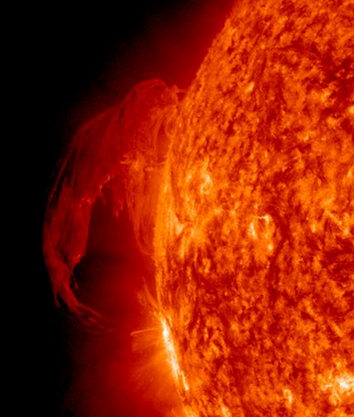
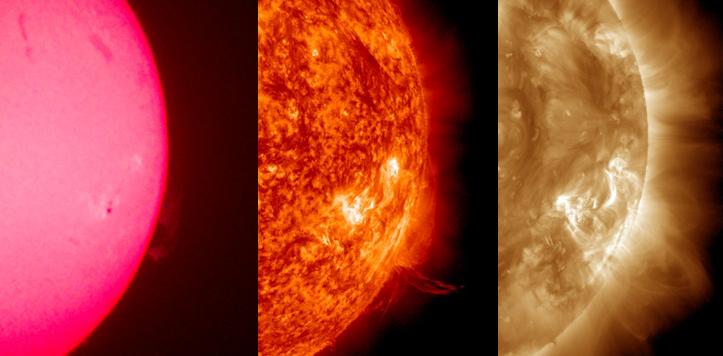
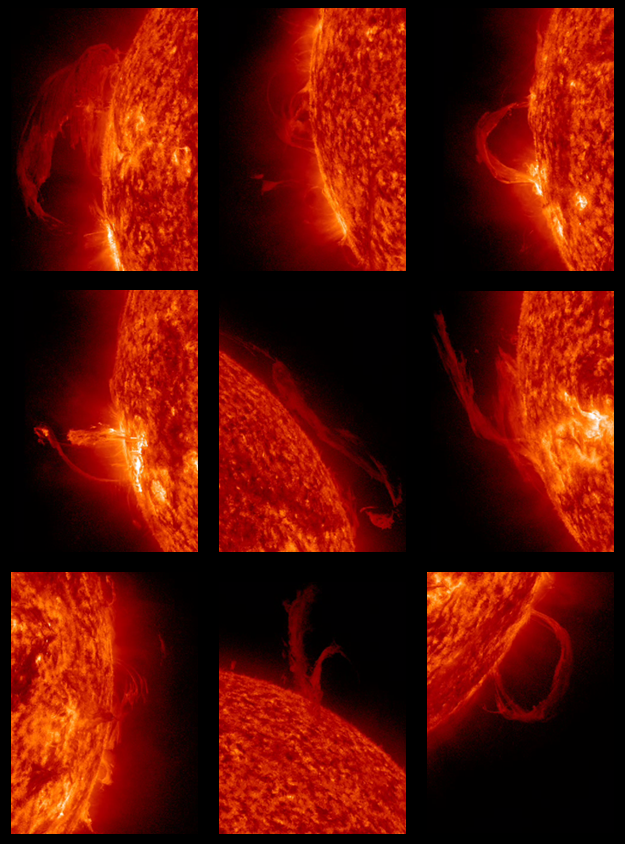
PROBA2, the technologically advanced ESA micro-satellite studying the Sun, has been in orbit since November 2009 (http://proba2.oma.be). Onboard, both the EUV imager SWAP and the EUV/UV radiometer LYRA have been acquiring unique data for more than three years. During that time, 25 PROBA2 Guest Investigators have visited the PROBA2 Science Center at the Royal Observatory of Belgium, in Brussels, to efficiently use PROBA2 data in their research.
A new Call for Ideas for the PROBA2 Guest Investigator Program is now open for the period October 2013 and May 2014.
Selected proposers will be invited to spend up to a few months with the PI teams to obtain expert knowledge on the instruments and to participate in the daily operations of SWAP and LYRA. Each guest investigator will be reimbursed for travel, accommodation and living expenses. Additional details about the PROBA2 Guest Investigator program and application information can be found on the PROBA2 website at:
http://proba2.oma.be/FourthGICall
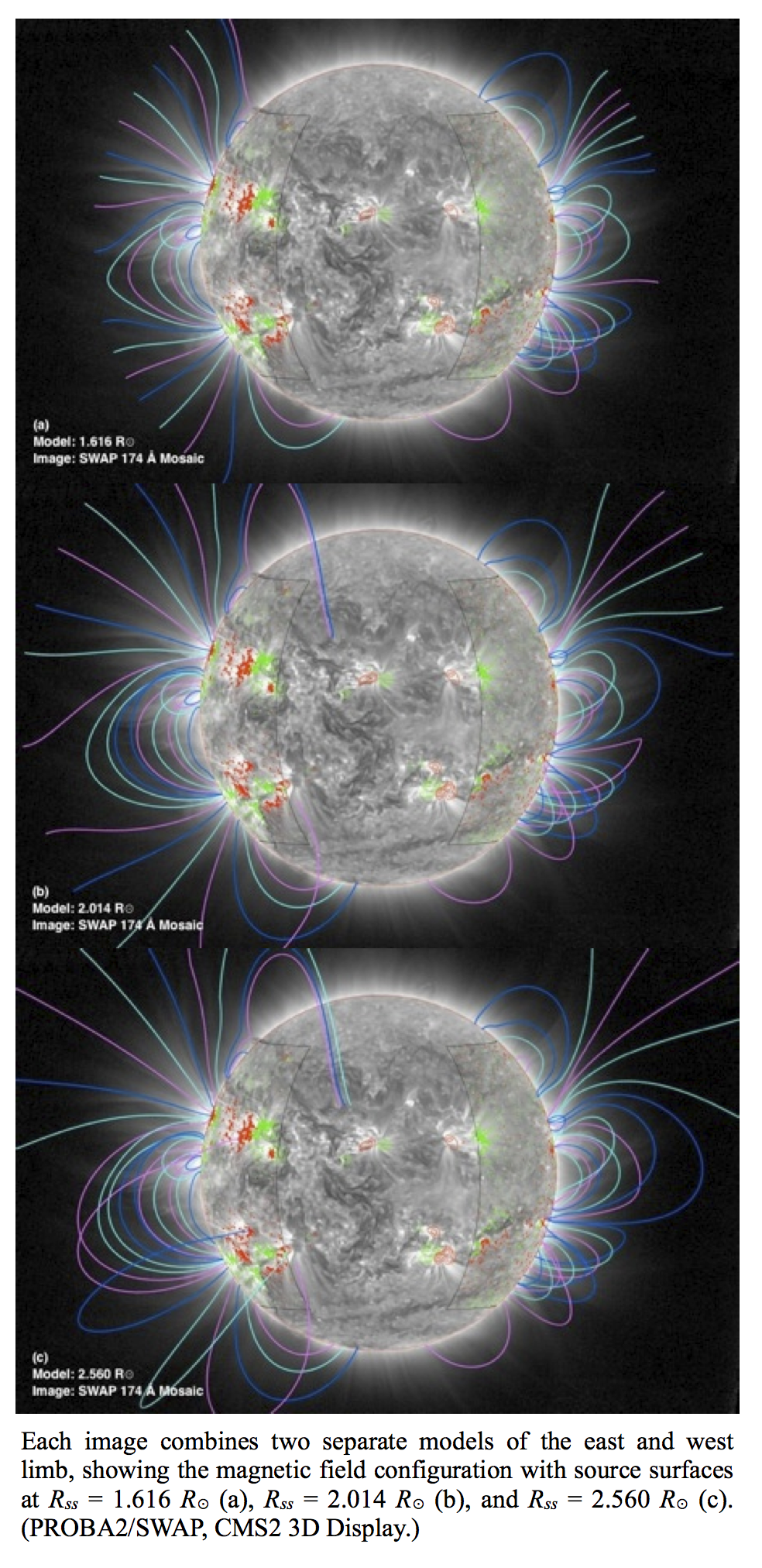
Nine active regions were reported by NOAA during the week (corresponding Catania sunspot group numbers are shown in brackets): 1793 (33), 1800 (35), 1799 (34), 1802 (36), 1803 (37 and 45), 1801 (38 and 41), 1804 (39), 1805 (44), and 1806 (50). The flaring activity was up to the low C-level and came almost exclusively from the NOAA AR 1800 (Catania sunspot group 35), with the strongest flare being the C3.2 flare peaking at 12:21 UT on July 28.
Three halo CMEs were detected by SOHO/LASCO during the week. On July 22 a full and a partial halo CMEs were detected, first appearing in the LASCO C2 field of view at 06:24 UT and 23:06 UT (after a data gap), respectively. The white cloud in the photo's made by the coronograph LASCO/C2 onboard of SOHO shows the first CME on 3 successive times.

The partial halo CME had the principal angle around 310 degrees and angular width of around 220 degrees. The CMEs had the plane-of-the-sky projected speeds around 850 km/s and 400 km/s, respectively. STEREO/SECCHI data demonstrate that these were farside CMEs erupted from the same source region situated around W160 (W170 at the time of the second CME) as seen from the Earth. These CME were therefore not geoeffective. The picture below is taken by STEREO Ahead in the EUV. It shows the back-side from the Sun. The action region indicated with the arrow is not visible from the Earth.
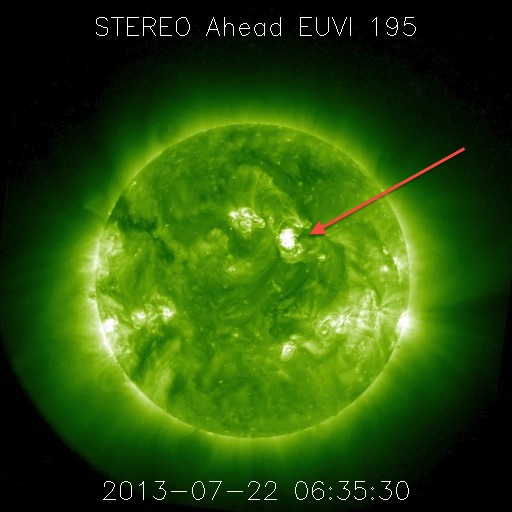
A partial halo CME (angular width around 135 degrees, principal angle 215 degrees) was detected by SOHO/LASCO on July 26 first appearing in the LASCO C2 field of view at 18:36 UT. It was accompanied by the C1.5 flare peaking at 19:28 UT situated just behind the south-west limb (a post-eruption arcade was detected by SDO/AIA). The CME speed was around 500 km/s according to the CACTus software. Due to the CME source region position behind the limb, this CME was not geoeffective either.
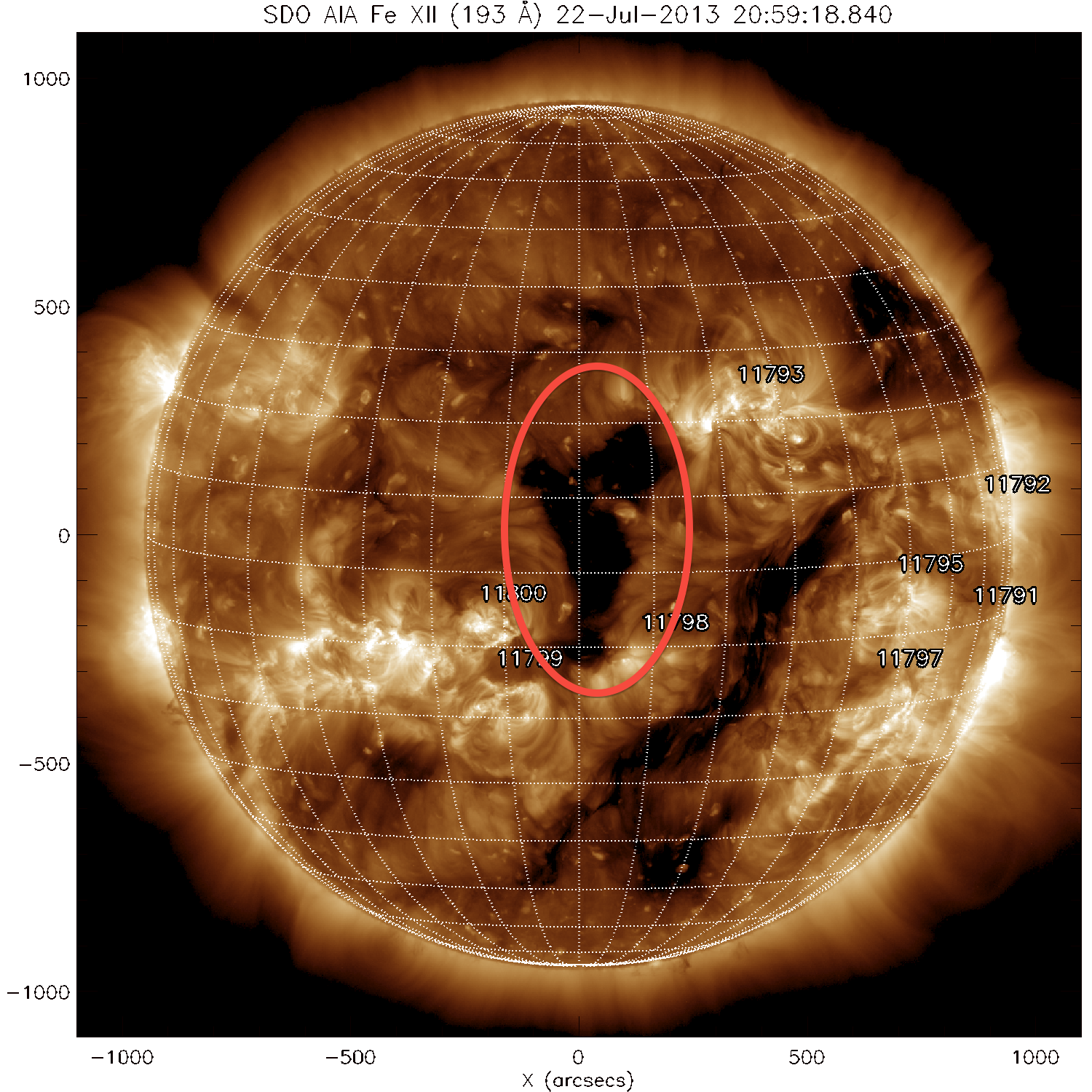
An equatorial coronal hole reached the solar central meridian on July 22. Above, a picture taken by SDO/AIA, 19.3 nm. The fast solar wind stream from this coronal hole arrived at the Earth early on July 26 (see also the section 'Review of geomagnetic activity').
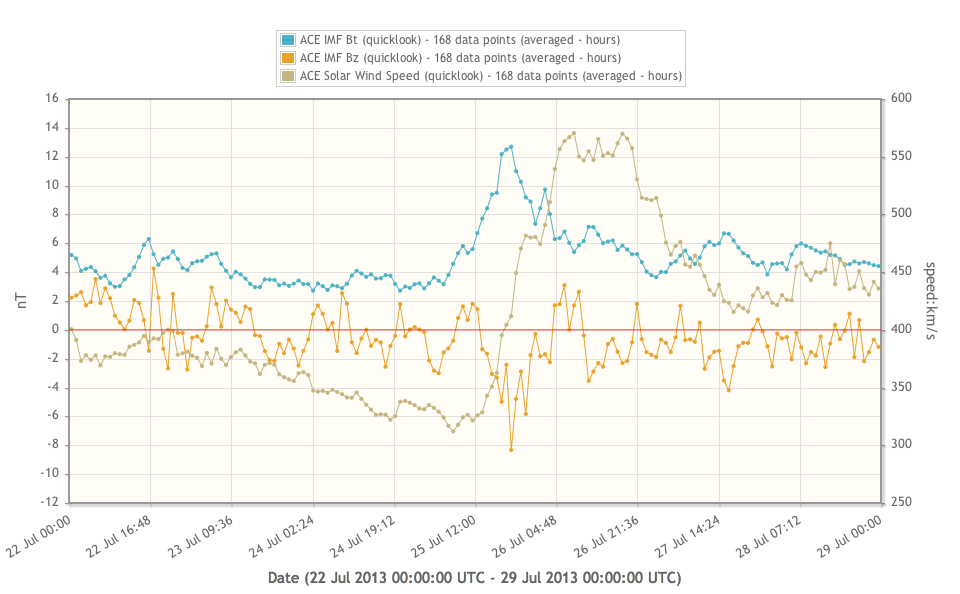
Solar (flaring) activity evolved from very low to low during week.
In order to view the activity of this week in more detail, we suggest to go to the following website from which all the daily (normal and difference) movies can be accessed: http://proba2.oma.be/ssa.
This page also lists the recorded flaring events.
A weekly overview movie can be found here: http://proba2.oma.be/swap/data/mpg/movies/WeeklyReportMovies/WR174_Jul22toJul28_2013/2013_07_22_00_00_07_2013_07_28_22_54_55_SWAP_174__AIA_304-hq.mp4 (SWAP174/AIA304 combination; HelioViewer.org).
Note that PROBA2 was off-pointed for a large part of the week, to track a large filament towards
the West limb.
Details about some of this week’s events, can be found further below.
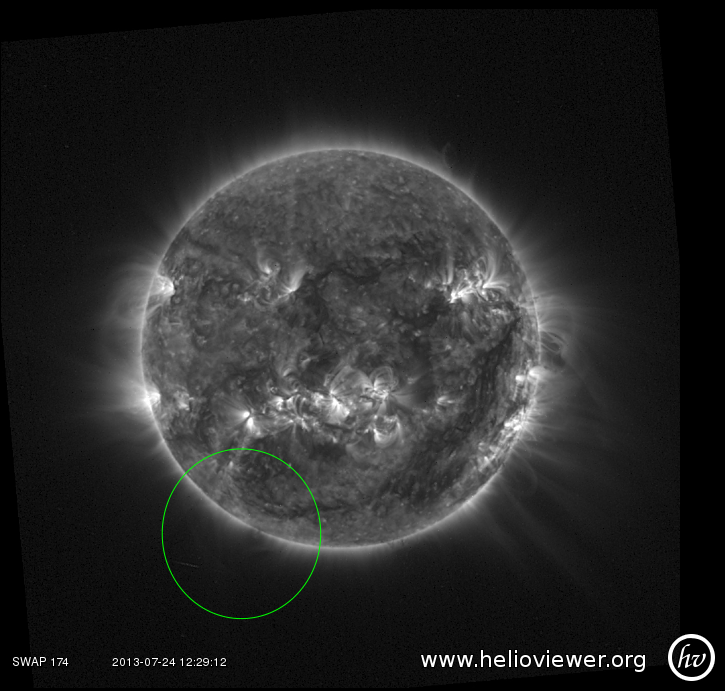
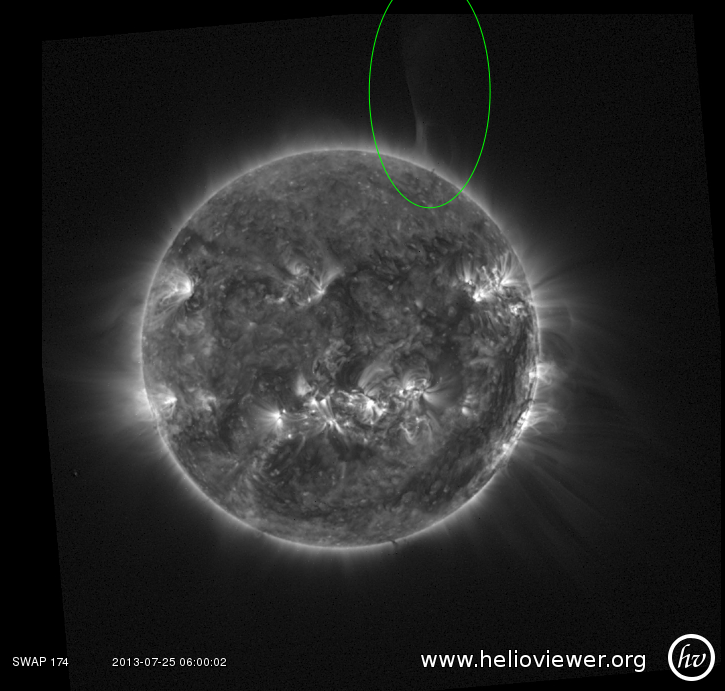
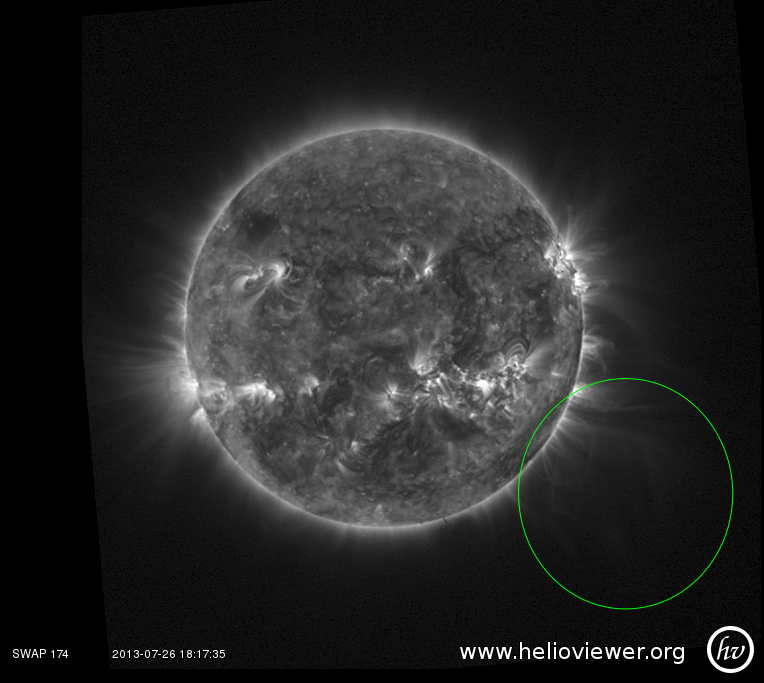
Capturing the eruption of the above prominence was the primary reason for this week's SWAP off-pointing campaign (see also the addendum to this bulletin).
The eruption of this filament generated a CME, captured by CACTus here: http://sidc.oma.be/cactus/catalog/LASCO/2_5_0/qkl/2013/07/CME0070/CME.html
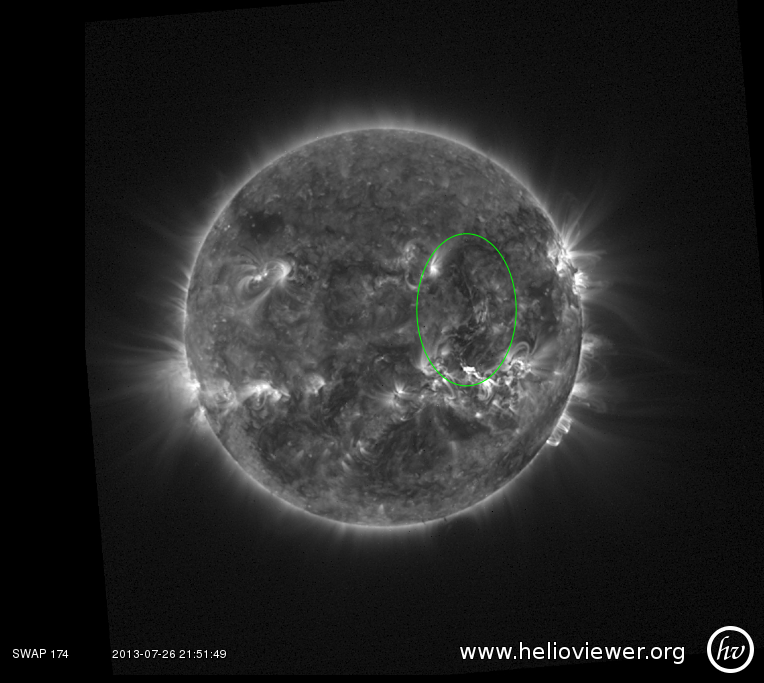
Find a movie of the event here: http://proba2.oma.be/swap/data/mpg/movies/WeeklyReportMovies/WR174_Jul22toJul28_2013/Events/Prominence_Eruption/20130726_C18_Eruption_2200_swap_diff_offpoint.mp4 (SWAP difference movie)
Special operations were executed to off-point PROBA2 in the direction of the Solar West limb.
A big filament, which had formed in the South was moving towards the west limb, and we were hoping that it might erupt when it got close to the limb. With PROBA2 off-pointed, we might thus be able to follow its eruption further away from the Sun than usual.
And we were lucky, the filament erupted indeed on Friday 26th, around 18:20. Below are provided some extra processed images and movies showing the eruption of the filament up to the limits of the SWAP field of view.
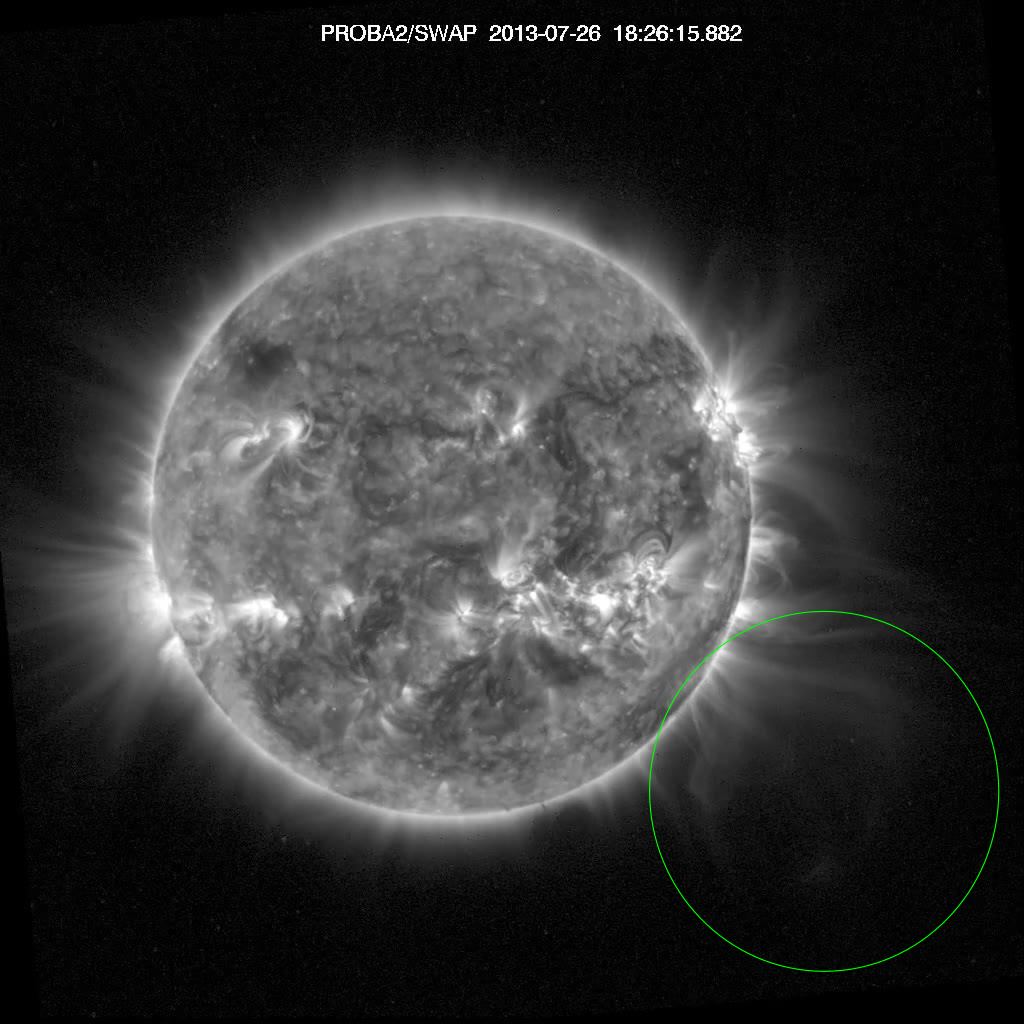
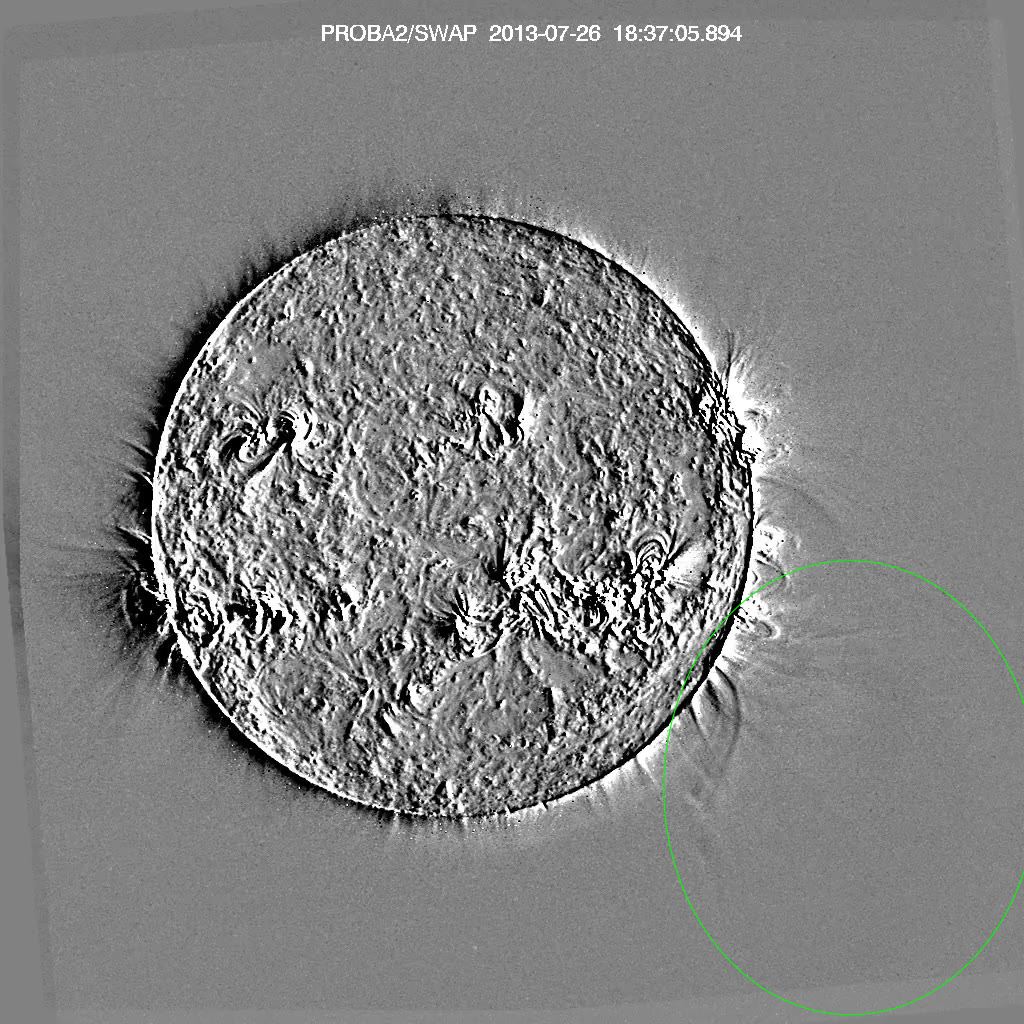
Find a movie of this occurrence (SWAP difference movie) here: http://proba2.oma.be/swap/data/mpg/movies/WeeklyReportMovies/WR174_Jul22toJul28_2013/Events/Prominence_Eruption/20130726_PromErupt_1837_swap_diff_offpoint.mp4
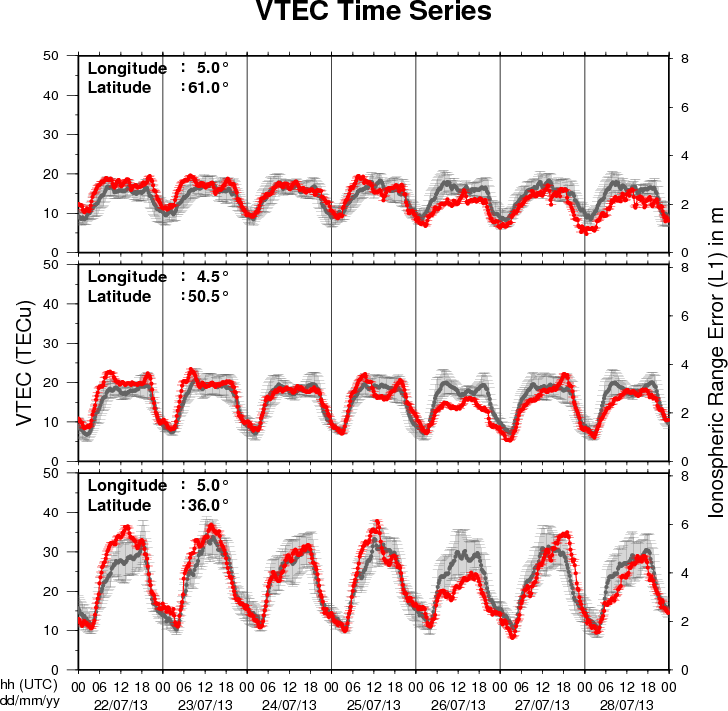
The figure shows the time evolution of the Vertical Total Electron Content (VTEC) (in red) during the last week at three locations:
a) in the northern part of Europe(N61°, 5°E)
b) above Brussels(N50.5°, 4.5°E)
c) in the southern part of Europe(N36°, 5°E)
This figure also shows (in grey) the normal ionospheric behaviour expected based on the median VTEC from the 15 previous days.
The VTEC is expressed in TECu (with TECu=10^16 electrons per square meter) and is directly related to the signal propagation delay due to the ionosphere (in figure: delay on GPS L1 frequency).
The Sun's radiation ionizes the Earth's upper atmosphere, the ionosphere, located from about 60km to 1000km above the Earth's surface.The ionization process in the ionosphere produces ions and free electrons. These electrons perturb the propagation of the GNSS (Global Navigation Satellite System) signals by inducing a so-called ionospheric delay.
See http://stce.be/newsletter/GNSS_final.pdf for some more explanations ; for detailed information, see http://gnss.be/ionosphere_tutorial.php
Start : 2013-08-05 - End : 2013-08-08
The goal of this workshop is to foster collaborations between
ground and space solar projects. This workshop is expected
* to provide a forum to discuss the use of current and future
observational solar facilities, and how to optimise their
scientific returns;
* to identify the potentially paradigm-shifting observations
that will become possible with the next generation ground- and
space-based solar telescopes and their advanced
instrumentation;
* to foster collaborations between researchers working at the
development of ground- and space-based projects and creation of
synergies between research programs at different wavelength
bands.
Website:
http://folk.uio.no/matsc/oslo-13/info.html
Start : 2013-08-05 - End : 2013-08-08
The goal of this workshop is to foster collaborations between
ground and space solar projects. This workshop is expected 1) to
provide a forum to discuss the use of current and future
observational solar facilities, and how to optimise their
scientific returns; 2) to identify the potentially
paradigm-shifting observations that will become possible with the
next generation ground- and space-based solar telescopes and their
advanced instrumentation; 3) to foster collaborations between
researchers working at the development of ground- and space-based
projects and creation of synergies between research programs at
different wavelength bands.
A workshop webpage and more information will follow shortly -
the purpose of this pre-announcement is to enable early bookings in
your calendar.
Start : 2013-08-16 - End : 2013-08-31
The Local Organising Committee and the Mexico National Committee
of IUGG have the great pleasure to welcome you to the 11th
Scientific Assembly of the International Association of
Geomagnetism and Aeronomy (IAGA) which is held in Mérida
Yucatán, Mexico from 26 to 31 August 2013 with the
motto: "Living on a Magnetic Planet". Our Magnetic Planet
Capricious (Changeable or Unpredictable) Field.
In order to increase the visibility and attractiveness of IAGA
to young researchers, to motivate them to play active role within
IAGA and to create (and enhance) their awareness of IAGA and sense
of belonging to IAGA, the first IAGA Summer School will be
organized just prior the Assembly. The summer school will provide
overview of the activities carried out within all the IAGA
divisions, with subjects from paleomagnetism and magnetic
anisotropy through observatories and geomagnetic field modeling to
ionospheric and aeronomic research. At least 20 young scientists
from all around the world will be invited based on the nominations
from Working Groups and Divisions. Special call and more
information will be published before the end of 2012.
Website: http://iaga2013.org.mx/
Start : 2013-08-25 - End : 2013-08-29
This conference will focus on instrumentation, observatories,
space missions, and programs for observations from the Sun to
Earth's upper atmosphere and space environment. The aim is to bring
together diverse communities working on all elements of solar
physics and space weather instrumentation.
Studying solar phenomena and monitoring space weather requires
observations using both space- and ground-based instrumentations
covering the different regions of the Sun-Earth system, the Sun,
interplanetary medium, magnetosphere, ionosphere, and thermosphere.
Papers are solicited concerning all instrumentation-supporting
solar physics and space weather. This includes, but is not limited
to, concepts, designs, fabrication processes, calibration, data
trending, information technologies, solar data mining, instrument
modeling, and satellite lifetime prediction modeling. We are also
interested in all past, current, and future solar space missions
and satellite and ground constellations of space weather
instrumentation with a strong focus on Space Situational
Awareness.
This conference is intended to provide the solar physics
community and that of Earth's space environment with a forum for
discussing the latest updates on instrumentation, observation
techniques, and programs in their respective fields, and for
proposing innovative ideas for future Sun-Earth coordinated
observations.
Website: http://spie.org/op423
Start : 2013-09-04 - End : 2013-09-06
The purpose of the meeting is to provide a forum for the italian
scientists in the field (some of which are abroad) to consolidate
on-going collaborations and establish new ones, for example in
future projects such as Solar Orbiter and EST, where several of us
are involved.
The meeting is obviously open to scientists from all the
countries!
Website:
http://www.oact.inaf.it/weboac/SoHe2013/
Start : 2013-09-08 - End : 2013-09-12
The European Solar Physics Meetings aim to highlight all aspects
of modern solar physics, including observation and theory that span
from the interior of the Sun out into the wider heliosphere. These
meetings provide a broad, yet stimulating, environment for European
and international scientists to share their research in solar
physics.
The meeting will mostly comprise of contributed talks and poster
presentations, with several invited review talks (typically one per
session). Posters will be on display for the whole meeting in close
proximity to the lecture theatre. Refreshments will be served in
the poster viewing area during two dedicated coffee/poster breaks
on each full day.
Website: http://www.espm14.ie/
Start : 2013-09-09 - End : 2013-09-14
We gain information about the universe through analysis of the
spectra from celestial objects. However, while the intensity
spectrum represents a scalar quantity but electromagnetic radiation
occurs in the form of transverse waves, the polarized spectrum
provides us with a 4-vector, the Stokes vector. The increased
amount of information space opens new windows to the universe, in
particular for the exploration of magnetic fields. It is well
recognized that the magnetic field is a primary agent responsible
for structuring and the source of all variability on intermediate
time scales, which manifests itself in all forms of solar and
stellar activity.
It is therefore not surprising that every year there are many
scientific meetings organized with the objective of studying the
role of magnetic fields in cosmic objects. What is largely missing
in these meetings is however an in-depth investigation of the
fundamental aspects of how magnetic fields can be determined by the
means of spectro-polarimetry, our main gateway to cosmic magnetism.
The primary aim of our series of Workshops is to address these
fundamental aspects, with less emphasis on the morphological and
physical properties of cosmic magnetic fields.
Website: http://spw7.ynao.ac.cn/
Start : 2013-09-16 - End : 2013-09-20
The meeting will cover a broad range of aspects of solar
physics, space science and solar-terrestrial relations. We aim to
include every side of solar and space research, including
observations, theory, and numerical modelling. The main idea behind
the meeting is to treat the entire solar-terrestrial domain as one
system, rather than each region independently.
The topics to be covered are:
* advanced solar observations
* waves and flows in the Solar atmosphere
* structure and dynamics of solar magnetic fields
* connecting analytical theory and modern numerical simulations
to observations
* new physics in numerical modelling
* linking solar interior with heliosphere
* particle acceleration in the Sun and heliosphere
* non-linear phenomena in space plasmas
* physics of magnetosphere and ionosphere
Website:
http://swat.group.shef.ac.uk/Conferences/Ukraine_UK_2013/index.html
Start : 2013-09-16 - End : 2013-09-19
This summer school targets to introduce a generation of young
researchers (advanced master students, PhDs, and junior
postdoctoral researchers) to the diverse aspects of space weather
related research.
It will introduce theoretical approaches to space weather and
its drivers, present modern solar data analysis tools, and cover
state-of-the-art solar and space science simulations. Participants
will learn about forecasting aspects and their quality control for
space weather events, but also experience hands-on training in
scientific proposal writing and receive do-and-don't tips for
scientific presentations.
The scientific program is enriched by a public evening lecture
on the solar influence on our climate, and the lecturers are
invariably expert scientists with international standing.
The school is open to a maximum of 40 participants, and can
benefit from its embedding within two international research
network activities: an Interuniversity Attraction Pole P7/08 CHARM
connecting heliospheric to astrophysical communities with 7 partner
institutes, and a European FP7 Project eHeroes with 15 different
partner institutes. Participation from outside both network
activities is strongly encouraged. Within Belgium, the school links
up expertise from universities (KU Leuven, ULB, Gent University) to
federal research institutes (the Solar-Terrestrial Centre of
Excellence, the Royal Observatory of Belgium and the Belgian
Institute for Space Aeronomy).
Website:
http://wis.kuleuven.be/CHARM/events/school/SSTW2013/
Start : 2013-10-07 - End : 2013-10-11
The aim of the workshop is to review the "state of the art"
theories about generation and propagation of Solar radio burst and
discuss the observational constrains and results that have been
provided in this area by the WIND & STEREO missions during the
last 20 years. Furthermore the STEREO & WIND observations will
be put in the context of other missions such as RHESSI and ground
based observatories. Finally, the preparation for the future
explorations foreseen with Solar Orbiter and Solar Probe Plus will
be discussed.
Website:
http://type3stereo.sciencesconf.org/
Start : 2013-10-24 - End : 2013-10-26
Initiated by Profs. Fang and Choudhury, the first Asian-Pacific
Solar Physics Meeting (APSPM) was held in Bangalore two years ago.
During the meeting, a consensus was achieved that it might be a
good idea to have the APSPM every three years. Somehow the second
APSPM was proposed to be held by mainland China in 2013. APSPM is
aimed to exchange the recent research results in solar physics in
the emerging asian-pacific region.
Asian-pacific regions are getting more and more active in solar
physics, as signified by the construction of big facilities,
including the Hinode satellite (Japan), SOXS (India), Chinese Solar
Radio Heliogragh, and Optical & Near-Infrared Solar Eruption
Tracer (ONSET). Therefore, colleagues have agreed to hold regional
solar physics meetings regularly. The first Asian-Pacific Solar
Physics Meeting (APSPM) was held in Bangalore during March 22-24
2011. During the meeting, a consensus was achieved that it might be
a good idea to have the APSPM every three years. Somehow the second
APSPM was proposed to be held by mainland China in 2013. APSPM is
aimed to exchange the recent research results in solar physics in
the emerging asian-pacific region.
Website:
http://sdac.nju.edu.cn/~solar/
Start : 2013-10-27 - End : 2013-10-31
Magnetic helicity has been intensively studied from
observational, theoretical, and many other aspects of solar
physics. For this meeting we would like to invite solar physicists
who are interested in the observational and theoretical studies of
the helicity, to encourage thorough discussions on the relevant hot
issues. The 1st Helicity Thinkshop was held successfully in 2009,
and now the 2nd one will be held on October 27-31, 2013 in Beijing,
China.
Website:
http://sun.bao.ac.cn/meetings/HT2013/
Start : 2013-10-28 - End : 2013-11-02
The Worshop and School on Radio Sun in Beijing and Inner
Mongolia during Oct.28 - Nov. 2, 2013 is the first international
academic seminar supported by the International Research Staff
Exchange Scheme of the Seventh Fromework Programme of the European
Union (FP7-IRSES-295272-RADIOSUN).
The primary aim of this programme is to establish close research
interaction and collaboration between the key research groups
involved in CSRH, SSRT, and ALMA projects and in development of
relevant theory and data analysis tools, through the systematic
research staff and knowledge exchange, joint research efforts
exploiting existing data and facilities, and preparing the future
world-class partnership in exploitation of the upcoming
facilities.
The Workshop and School welcome all solar physicsts and students
who are interested in solar radio astronomy to participate. We will
discuss and exchange the scientific frontier problems, including
the new-generation radio instruments (CSRH, Siberian
multi-frequency radioheliograph, LOFAR, ALMA, and other new
instruments), recent achievements and their scientific goals;
methods and techniques of data processing (for example, software,
radio image reconstructions, and method for studying various types
of solar radio fine structures); and the objectives of new
observational data and new mathematical methods.
Website:
http://beijingradiosun.csp.escience.cn/
Start : 2013-11-11 - End : 2013-11-22
Magnetic fields play an important role in many astrophysical
processes. But magnetic are difficult to detect and to model or
understand, since the fundamental equations describing the behavior
of magnetized plasmas are highly non-linear. Hence, magnetic fields
are often an inconvenient subject which is overlooked or simply
neglected. Such difficulty burdens the research on magnetic fields,
which has evolved to become a very technical subject, with many
small disconnected communities studying specific aspects and
details.
The school tries to amend the situation by providing a unifying
view of the subject. The students would have a chance to understand
the behavior of magnetic fields in all astrophysical contexts, from
cosmology to the Sun. From star-bursting regions to AGNs in
galaxies. The school will present a balanced yet complete review of
our knowledge. Extensions into the unknown are also important to
indicate present and future lines of research.
The Winter School will bring together in a relaxed working
atmosphere a number of the leading scientists in this field, PhD
students and recent postdocs. The conditions for a successful
interaction will be granted, including two special sessions for
those students that want to present their own work.
Website:
http://www.iac.es/winterschool/2013/
Start : 2013-11-12 - End : 2013-11-15
Since its launch in Sep-2006, more than 600 refereed papers have
been published based on Hinode observations, presenting many new
and important findings to the scientific community. However, due to
the unexpectedly low levels of solar activity, until now the focus
has mainly been on the more quiescent aspects of the solar cycle.
With the solar maximum expected this year, through cooperative
observations with SDO, IRIS, and ground based observatories, Hinode
observations should lead to our understanding of active Sun
phenomena, such as solar flares and CMEs, to be greatly improved.
Making Hinode-7 an excellent opportunity to discuss solar activity
in the current solar cycle and the related science through the use
Hinode data, as well as other solar/space weather data. It will
also be interesting to use this meeting to broaden our focus to
include the solar-stellar connection as a means to deepen our
understanding of solar activity.
Momentum is also gaining for Solar-C, which is being developed
as an international collaboration between Japan, US and Europe. To
further discuss this mission, the Solar-C science meeting will be
held on 11-Nov.
Website:
http://www.kwasan.kyoto-u.ac.jp/hinode-7/
Start : 2013-11-18 - End : 2013-11-22
This International CAWSES-II Symposium hosted by SCOSTEP
(Scientific Committee on Solar-Terrestrial Physics) will provide an
excellent opportunity to discuss the scientific accomplishments of
CAWSES-II and look forward to SCOSTEP's future programs at a moment
toward the end of its five-year period. The symposium will cover
the six major themes of CAWSES-II tasks: 1) What are the solar
influences on the Earth's climate?, 2) How will geospace respond to
an altered climate?, 3) How does short-term solar variability
affect the geospace environment?, 4) What is the geospace response
to variable inputs from the lower atmosphere?, 5) Capacity
Building, 6) Informatics and eScience. The main functions of
CAWSES-II are to help coordinate international activities in
observations, modeling, and applications crucial to achieving this
understanding, to involve scientists in both developed and
developing countries, and to provide educational opportunities for
students of all levels. The symposium offers keynotes/lectures that
will be interesting for all participants every morning and more
specific sessions of presentations in the afternoon. We welcome all
those who are involved and/or interested in CAWSES-II to Nagoya in
the autumn when we will have the pleasure of being surrounded by
beautiful colorful leaves of this season.
Website:
http://www.cawses.org/CAWSES/leaflet_CAWSES-II_120229.pdf
Start : 2013-11-18 - End : 2013-11-22
The 10th Edition of the European Space Weather
Week will take place on 18-22nd
November 2013 in Belgium. The venue will be confirmed early next
year, but mark your calendars now for the 10th Anniversary of this
growing European event.
The ESWW will again adopt the central aim of bringing together
the diverse groups in Europe working on different aspects of Space
Weather
. This includes but isn't
limited to the scientific community, the engineering community,
applications developers, service providers and service end users.
The meeting organisation will again be coordinated by the Belgian
Solar-Terrestrial Centre of Excellence (STCE), ESA
and the Space Weather
Working Team. The local
organisation will be done by the STCE.
Website:
http://www.stce.be/esww10/
Start : 2014-08-02 - End : 2014-08-10
The 40th COSPAR Scientific Assembly will be held in Moscow,
Russia from 2 - 10 August 2014. This Assembly is open to all bona
fide scientists.
Website:
http://www.cospar-assembly.org/
http://www.spaceweather.eu/en/repository/show?id=476
http://www.spaceweather.eu/en/repository/show?id=477